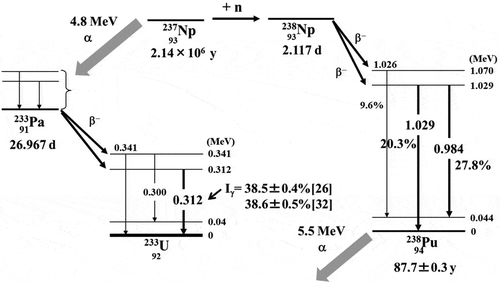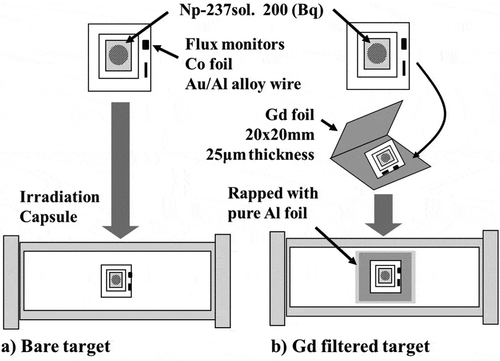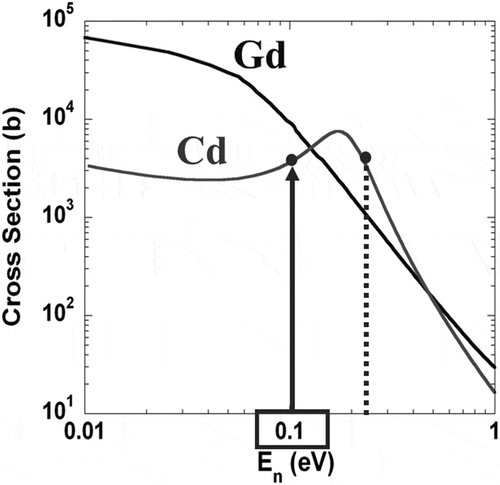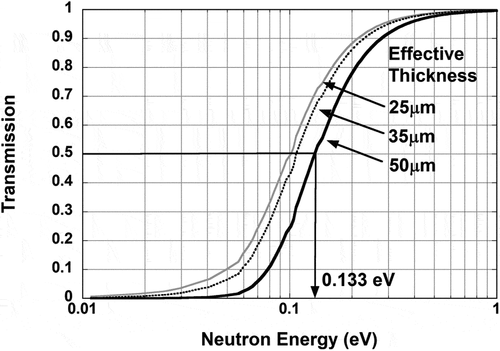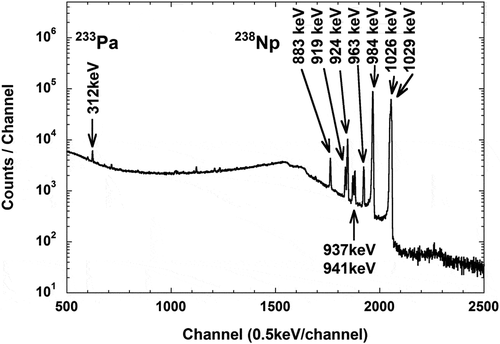 ?Mathematical formulae have been encoded as MathML and are displayed in this HTML version using MathJax in order to improve their display. Uncheck the box to turn MathJax off. This feature requires Javascript. Click on a formula to zoom.
?Mathematical formulae have been encoded as MathML and are displayed in this HTML version using MathJax in order to improve their display. Uncheck the box to turn MathJax off. This feature requires Javascript. Click on a formula to zoom.ABSTRACT
The thermal-neutron capture cross-section (σ0) and resonance integral (I0) were measured for the 237Np(n,γ) 238Np reaction by an activation method. A method with a Gadolinium filter, which is similar to the Cadmium difference method, was used to measure the σ0 with paying attention to the first resonance at 0.489 eV of 237Np, and a value of 0.133 eV was taken as a cut-off energy. Neptunium-237 samples were irradiated at the pneumatic tube of the Kyoto University Research Reactor in Institute for Integral Radiation and Nuclear Science, Kyoto University. Wires of Co/Al and Au/Al alloys were used as monitors to determine thermal-neutron fluxes and epi-thermal Westcott’s indices at an irradiation position. A γ-ray spectroscopy was used to measure activities of 237Np, 238Np and neutron monitors. On the basis of Westcott’s convention, the σ0 and I0 values were derived as 186.9 ± 6.2 barn, and 1009 ± 90 barn, respectively.
1. Introduction
Associated with the public acceptance of nuclear power reactors, it would be desired to overcome issues of nuclear wastes of minor actinides (MAs) existing in spent nuclear fuels. Neptunium-237, americium-241, and americium-243 among MAs are of importance in the nuclear waste management, because the presence of these nuclides causes long-term radiotoxicity on account of their relatively long half-lives. For example, 237Np has the extremely long half-life of 2.14 × 106 years [Citation1]. As one candidate to solve the problems, a method of converting radio nuclides to stable ones, that is, ‘nuclear transmutation’ has recently been studied again. The ‘nuclear transmutation’ was extensively studied as known as ‘OMEGA Project’ in the 1980’s. In response to a recent trend, the ‘ImPACT’ project [Citation2] has been promoted for long-lived fission products. When nuclear transmutation of 237Np is considered by using neutron capture reaction, the accurate neutron capture cross-section of 237Np is required to evaluate the transmutation rate and/or reaction rate. Furthermore, the build-up of nuclear fissile nuclides through 237Np is important not only for nuclear waste management, but also for the nuclear fuel cycle. illustrates a part of the nuclear chart displaying relevant reactions and decays [Citation1]. It is well known that the basic concept for Fast Breeder Reactor is attributable to the following reaction chain: 238U → 239U → 239Np → 239Pu (nuclear fuel). One finds that 237Np contributes generation of Pu isotopes through neutron capture reactions and decays: 237Np → 238Np → 238Pu and higher order Pu isotopes. Therefore, the neutron capture cross-section of 237Np is also important in the view point of predicting the production amount of Pu isotopes.
In the transmutation and/or burn-out studies of 237Np by using reactor neutrons, accurate data of neutron capture cross-sections are required to evaluate reaction rates as mentioned above. The accurate data with 5% error on the neutron capture cross-section of 237Np have been required as registered in the World Request List for Nuclear Data: WRENDA91/92 [Citation3]. Measured and evaluated cross-section data for the 237Np(n, γ)238Np reaction are plotted in [Citation4–Citation19]. Conflicting data have been reported by many measurements for the thermal-neutron capture cross-section (σ0) of 237Np from the 1960s to the beginning of the 2000s as seen from . One finds that the data greatly vary more than their measurement errors, and past reported data are distributed around 170 barn and 180 barn.
Figure 2. Past reported values for the thermal-neutron capture cross-section of 237Np [Citation4-Citation19]. Data marked in italics indicate evaluated ones
![Figure 2. Past reported values for the thermal-neutron capture cross-section of 237Np [Citation4-Citation19]. Data marked in italics indicate evaluated ones](/cms/asset/c79159cf-b5c8-4bb7-9733-7f2351a6ce8a/tnst_a_1598304_f0002_b.gif)
As reasons of such discrepancies, two points could be considered as follows: (1) It seems that these discrepancies in the thermal-neutron capture cross-sections might be caused by taking 0.5 eV as the cut-off energy in measurements. plots the neutron capture cross-section curve of 237Np. Since 237Np has the huge first resonance at the neutron energy of 0.489 eV, the conventional cut-off energy of 0.5 eV cannot be applied for 237Np. When a 1mm-thick Cd filter was used to take 0.5 eV as the so-called ‘Cd cut-off energy,’ contributions to the reaction by the first resonance, which is not sufficiently shielded, would result in overestimation for the thermal-neutron capture cross-section of 237Np. In view of behavior of the cross-section curve in , the cut-off energy of around 0.1 eV could get rid of the influence of the first resonance at 0.489 eV. (2) Data of γ-ray emission probabilities used for analysis are also considered to be one of factors that cause discrepancies. When quantitating the amount of 237Np target and 238Np reaction product by a γ-ray spectroscopy, emission probabilities of 312-keV γ ray emitted from 233Pa in radiative equilibrium with 237Np, and of 984-keV γ rays from 238Np directly affect the result of the neutron capture cross-section of the 237Np(n, γ)238Np reaction. As well as examining the evaluated data of γ-ray emission probabilities used for analysis, it is also necessary to re-measure and verify γ-ray probabilities if necessary.
Figure 3. Cross section curves of 237Np from evaluated libraries of JENDL-4.0 [Citation16] and ENDF/B-VII [Citation17].
![Figure 3. Cross section curves of 237Np from evaluated libraries of JENDL-4.0 [Citation16] and ENDF/B-VII [Citation17].](/cms/asset/fe753637-a77d-4bd5-b7a4-1e83d1829fa8/tnst_a_1598304_f0003_b.gif)
Thus, present work is aimed to confirm that there would be problems in how to set the cut-off energy, and then to measure the thermal-neutron cross-section σ0 and resonance integral I0 of the 237Np(n, γ)238Np reaction.
2. Experiments
2.1. Target preparation and irradiations
The partial decay scheme of 237Np is drawn in . In this study, the amount of the 237Np samples was quantified by the γ-ray spectroscopy for 312-keV γ ray emitted from 233Pa. The 984-keV γ rays emitted from 238Np generated after neutron irradiation and 312-keV γ rays are simultaneously measured in consideration of loss in sample preparations and neutron irradiations. The reaction rate can be derived by taking a ratio of yields of these γ rays [Citation13]. As the ratio is taken, there are the following advantages: the dead time of the γ-ray measurements is cancelled out, relative detection efficiencies are sufficient for analysis, and the error of a calibration source used for detection efficiencies is also cancelled.
Certainly, even in the case of α-ray measurements, an amount of 237Np can be quantified with 4.8-MeV α ray. Then, let 238Np generated sufficiently decay into 238Pu. By measuring 5.5-MeV α ray from 238Pu, the product amount of 238Np is evaluated, and then the reaction rate of 237Np(n, γ)238Np can be derived. However, it is necessary to carry out α-ray measurements by exposing the samples. At that time, loss in handling samples is concerned. Furthermore, since the α-ray energies are close to 4.8 MeV and 5.5 MeV, it is also concerned that 5.5-MeV α-ray peak tails in a low energy side because of a sample thickness and affects the 4.8-MeV α-ray peak. In any case, 238 Np (2.117 days [Citation1]) must be sufficiently decayed out after the neutron irradiation, and therefore we decided to carry out the experiments only with the γ-ray spectroscopy from the viewpoint of rapid experiments.
schematically gives an outline of target compositions. A 237Np standardized solution (0.5 mol/L(M) HCl), which was supplied by Nycomed Amersham plc., was used for 237Np samples. Its product code was NGZ44, and its specific activity was 231 kBq per gram of solution. Six 237Np standardized solutions equivalent to about 200 Bq (0.5 μl), were dropped onto pieces of glass micro filters by a glass capillary. The filters were dried by an infrared ramp. After drying, each filter impregnated with the 237Np solution was sealed with a polyethylene vinyl film. These were used as the 237Np samples.
Wires of Au/Al alloy (Au: 0.112 ± 0.01 wt%, 0.510 mm in diameter) and Co foils (Co: 99.9 ± 0.1% in purity, 5μm in thickness) were used to monitor neutron fluxes at an irradiation position. Since 59Co and 197Au have different sensitivities to thermal and epi-thermal neutrons, those nuclides are appropriate to determine the thermal and epi-thermal fractions in the neutron flux. The amount of 59Co and 197Au contained in each wire and foil was determined by weight measurements with a microbalance (METLER TRED UMT2). Nuclear data for monitor wires are summarized in [Citation1,Citation20,Citation21]. A set of Co and Au monitors was rapped with a polyethylene vinyl film, and attached to the 237Np sample. The 237Np sample with the monitor set was used as an irradiation target (called ‘a bare target’). The target was housed in the polyethylene capsule for the Pneumatic tube of the KUR. In this way, three capsules were prepared for irradiations with no filter.
Table 1. Nuclear data used for the monitor wires [Citation1,Citation20,Citation21]
For the remained three 237Np samples, the same monitor set was attached to each of them to obtain the resonance integral, and then the 237Np sample was sandwiching both sides with a Gadolinium (Gd) foil of 20 mm × 20 mm × 25mm μmt size (called ‘a Gd filtered target’). Each Gd filtered target was housed in the polyethylene capsule. Three capsules were also prepared for irradiations with the Gd filter. Here, the reason for choosing the 25-μm-thickness Gd filter is as follows: In this work, careful attention was paid to huge resonances of 237Np at the neutron energy of 0.489 eV as shown in . The cut-off energy of 0.1eV could avoid this resonance. However, it is not always good to give the cut-off energy of 0.1 eV using a Cadmium (Cd) filter with an adequate thickness as usual. draws cross-section curves of natCd and natGd. When using the Cd filter with the thickness giving the cut-off energy of 0.1 eV, as shown in , neutron shielding starts around 0.2 eV where the cross section becomes equal to that at 0.1 eV. Furthermore, since the cross sections of Cd gradually decrease from 0.2 eV, neutrons with energy less than 0.1 eV will pass through the Cd filter. That is, the usual Cd-ratio method [Citation22] cannot be applied. Although the Cd filter is convenient for setting usual cut-off energy (0.5 eV), it is not suitable for setting lower energy to avoid a resonance like present case. On the other hand, cross sections of Gd have a linear increase behavior down to 0.1 eV and gently increases with energy lower than 0.1 eV. Since Gd has the large neutron capture cross-section as about 10,000 barn at 0.1 eV, it would be effective to filter thermal neutrons. Therefore, Gd was used in the present experiments as the filter instead of Cd in the usual Cd-ratio method.
The thickness of the Gd filter was optimized in the neutron transmission. Results of neutron transmission in changing the thickness of Gd foils are plotted in . When using a 25-μm-thickness Gd foil, the effective thickness [Citation23] is estimated as 50 μm. The effective thickness is a mean pass length that isotropic neutrons take when they pass through a sample with a certain thickness. The energy at which transmission is halved can be estimated as 0.133 eV as seen from . Thus, the 25-μm-thickness Gd foil was chosen, and the cut-off energy was set as 0.133 eV in the present experiments.
Neutron irradiations were carried out using the pneumatic tube Pn-2 of the Kyoto University Research Reactor (KUR) of the Kyoto University Research Reactor Institute (current name, Institute for Integrated Radiation and Nuclear Science, Kyoto University). The KUR was operated under 1 MW power. Irradiations of bare and Gd filtered targets were performed for 10 and 5 min, and done three times, respectively.
2.2. Activity measurements
The γ rays from irradiated monitor wires were measured by a high-purity Ge-detector whose performance was characterized by a relative efficiency of 25% to a 7.6 cm × 7.6 cmϕ NaI (Tl) detector and an energy resolution of 1.9 keV full width at half-maximum (FWHM) at the 1.33 MeV peak of 60Co. The peak detection efficiencies were determined with a set of calibrated mixed sources: 113Sn, 137Cs, 88Y, and 60Co. The error of the detection efficiency due to the uncertainties of the calibration γ source intensities was estimated as 2%. The radioactivities of 237Np samples and flux monitors were measured at a distance of 100 mm from the surface of the detector head to the samples. shows the γ-ray spectrum obtained by the 237Np sample irradiated without the Gd filter. The irradiation time was 600 s and the live time of the measurement was 13,704 s. The 312-keV γ ray due to 233Pa and γ rays with energies from 883 keV to 1029 keV ascribed to 238Np were measured with good signal to noise ratio.
3. Analysis
3.1. Westcott’s convention
Since the details of the convention and/or theory that we used to determine the thermal-neutron capture cross-section and resonance integral were described elsewhere, here we present only a simple outline of Westcott’s Convention [Citation24,Citation25]. The effective cross-section is defined by equating the reaction rate R to product of
and nυ0:
where nυ0 is the ‘neutron flux’ in the convention with the neutron density n, and with the velocity of neutron υ0 = 2,200 m/s.
When the cross-section behavior departs from the 1/υ law, a simple relation for can be obtained as follows:
where σ0 is the thermal-neutron capture cross-section; g is a factor as a function of the temperature related to departure of the cross-section behavior from the 1/υ law; r is an epithermal index in Westcott’s convention.; T is neutron temperature and T0 is 293.6 K; the quantity r(T/T0)1/2 gives the fraction of epithermal neutron in the neutron spectrum; the Gth and Gepi denote self-shielding coefficients for thermal and epi-thermal neutrons, and they are taken as unity in this analysis under the present sample conditions. The value of 0.988 [Citation19] was taken as Westcott’s g-factor [Citation24] for 237Np. The parameter s0 is defined by:
where I0ʹ is the reduced resonance integral, i.e. the quantity obtained by subtracting a 1/υ-component from the resonance integral I0. The resonance integral I0 is expressed by:
where the term I(1/υ) in EquationEquation (4)(4)
(4) is the 1/υ contribution to the resonance integral above the cut-off energy Ec and derived as:
where E0 is the thermal neutron energy 25.3 meV.
3.2. Neutron flux and cross-section determination
Substituting EquationEquation (2)(2)
(2) into EquationEquation (1)
(1)
(1) , reaction rates can be written in the simplified forms as:
for irradiation without a Gd filter, and
for irradiation with a Gd filter. Here the ϕ1 and ϕ1ʹ are neutron flux components in the thermal energy region; the ϕ2 and ϕ2ʹ are those in the epi-thermal energy region. The prime (ʹ) refers to irradiation with a Gd filter. The reaction rates were calculated from peak counts of γ rays from 60Co and 198Au. shows the experimental relation between R/σ0 (or Rʹ/σ0) and s0 obtained by the flux monitors.
The values of s0, I0 for monitors are summarized in . The neutron flux components ϕ1 and ϕ1ʹ are derived with the relation in ; the slope of each solid line gives the epi-thermal flux components, i.e. ϕ2 or ϕ2ʹ. For example, the thermal-neutron flux component in the irradiation #1 was (4.44 ± 0.11) × 1012 n/cm2/s. lists the results of reaction rates R and Rʹfor the flux monitors and neutron flux components ϕ1, ϕ2 , ϕ1ʹ, and ϕ2ʹ, which were obtained for three sets of irradiation. Here the systematic errors for the reaction rates of the monitors were examined quantitatively as summarized in .
Table 2. Reaction rates for neutron monitors and neutron flux components at Pneumatic tube of KUR
Table 3. Systematic errors for flux monitor measurements
Solving EquationEquations (6)(6)
(6) and (Equation7
(7)
(7) ) for the parameter s0, the s0 is written as:
The parameter s0 is obtained from the ratio of R to Rʹ for irradiated target samples and the neutron flux components ϕ1, ϕ2, ϕ1ʹ, and ϕ2ʹ obtained by flux monitors in . The σ0 is obtained by substituting the parameter s0 into EquationEquation (6)(6)
(6) , and then the I0ʹ is derived from EquationEquation (3)
(3)
(3) . For Ec = 0.133 eV, the 1/υ contribution to the resonance integral is estimated to be I(1/υ) = 0.862 σ0 from EquationEquation (5)
(5)
(5) . Finally, the resonance integral I0 is given as:
4. Results and discussions
The amounts of 237Np and produced 238Np in the samples were obtained from γ-ray yields, and the reaction rates of the 237Np(n,γ)238Np reaction for three sets of irradiation were derived as listed in . The systematic errors were examined quantitatively as summarized in .
Table 4. Experimental results of the reaction rates of the 237Np(n,γ)238Np reaction
Table 5. Systematic errors estimated for the 237Np reaction rate in this experiment
The detection efficiencies derived from the same efficiency curve were used for analyzing spectral data of monitors and 237Np samples. When the error of the calibration source is taken into consideration for the reaction rates of the monitors and 237Np samples, the total systematic error would be overestimated.
It should be noted that the systematic error due to the calibration source is canceled when dividing the reaction rates of 237Np samples by those of the monitors in the derivation of cross sections. That is, the cross section of 237Np is obtained by comparing the cross sections of 197Au and 59Co monitors. This is why the errors obtained by fitting the efficiency curve were considered in the systematic error in the reaction rates of the monitors and 237Np samples.
Here we also examined the gamma-ray emission probabilities among the data required for deriving the reaction rates of the 237Np samples. Results of examining gamma-ray emission probabilities are summarized in and [Citation26–Citation38]. The gamma-ray emission probability Iγ for 312-keV γ ray emitted from 233Pa was used as 38.5 ± 0.4% by Terada et al. [Citation26], because it was the latest data at the present time. Firstly, they quantified a 237Np sample by γ-ray spectroscopy and determined its radioactivity. Next, 312-keV γ rays emitted from 233Pa in radiative equilibrium with 237Np were measured by γ-ray spectroscopy. The gamma-ray emission probability was derived from the radioactivity of 237Np and the yields of 312-keV γ ray.
Table 6. Gamma-ray emission probabilities Iγ for 312-keV gamma ray from 233Pa
Table 7. Gamma-ray emission probabilities Iγ for 984-keV gamma ray from 238Np
The gamma-ray emission probability for 984-keV γ ray emitted from 238Np was reported to be 25.19 ± 0.21% [Citation36] by 4πβγ coincidence measurement, which was smaller than the previous value of 27.8% [Citation37]. Subsequently, Harada et al.[Citation14]. derived the value of 25.20 ± 0.13% by α- and γ-ray spectroscopic methods. The value of Ref. [36] was used for the present analysis because the same result was obtained with higher accuracy by using different measurement method from that of the preceding study.
The thermal-neutron capture cross-section σ0 and resonance integral I0 were derived by analysis based on Westcott’s convention with the obtained reaction rates and information on the neutron flux components. The results of σ0, s0, I0ʹ, and I0 obtained by the three irradiation sets are summarized in together with the weighted averages. Firstly, the thermal-neutron capture cross-section σ0 and the parameter s0 were derived for three irradiation sets only with the statistical error, and then weighted averages were obtained both for the σ0 and s0. The variations in values due to irradiations were estimated to be ±3 barn for the σ0 and ±0.3 for the s0, respectively. Next, for the results of the weighted averages of the σ0and s0, the systematic errors and the error of the variation due to measurement were taken into consideration. Finally, I0ʹ and I0 were derived from EquationEquations (3)(3)
(3) and (Equation9
(9)
(9) ) using the σ0 and s0 in consideration of systematic errors as described above. In the present work, the thermal-neutron capture cross-section σ0 was obtained as 186.9 ± 6.2 barn. The present results for the thermal-neutron capture cross-section σ0 and the resonance integral I0 are summarized in together with the past reported values and evaluations. The evaluation value based on reported experimental data is 178.1 barn in JENDL-4.0 [Citation16], and the present result is found to be about 5% larger than that. That is, 237Np tends to absorb thermal-neutrons by about 5% from the evaluated data. Neptunium-237, which has along half-life of 2.14 × 106 years [Citation1], is transmuted to 238Np through the neutron capture reaction. Since 238Np decays in only 2.117 days [Citation1], it is expected to artificially accelerate the decay of long lived 237Np nuclide.
Table 8. Resultsa of σ0, s0, I0ʹ, and I0 for the 237Np(n,γ)238Np reaction
Table 9. Present and reported values for 237Np capture cross-section and resonance integral
5. Conclusion
The thermal-neutron capture cross-section and the resonance integral of the 237Np(n,γ) 238Np reaction were measured by the activation method. With careful attention to the first resonance of 237Np, the cut-off energy was taken as 0.133 eV with the Gd filter having appropriate thickness. The thermal-neutron capture cross-section σ0 was obtained as 186.9 ± 6.2 barn on the basis of the Westcott’s convention. The resonance integral I0 was obtained as 1009 ± 90 barn under the condition that the cut-off energy was 0.133 eV. The thermal-neutron capture cross-section of 237Np was obtained with the error of 3.3% which satisfied the requirement of 5% in the World Request List.
Acknowledgments
The authors would like to appreciate staffs of Kyoto University Research Reactor Institute for their support. This work has been carried out in part under the Visiting Researcher’s Program of the Research Reactor Institute, Kyoto University. One of the authors (S.N.) would also like to express our gratitude to Makoto ISHIKAWA, Dr. Hideo HARADA and Dr. Osamu IWAMOTO of JAEA for their constructive comments and encouragement.
Disclosure statement
No potential conflict of interest was reported by the authors.
Additional information
Funding
References
- Firestone RB, Shirley VS, Baglin CM, et al. Table of Isotopes. 8th ed. New York: John Wiley and Sons; 1995.
- [cited 2018 Nov 25]. http://www.jst.go.jp/impact/index.html
- Nakajima Y, Fukahori T. Japanese request list of nuclear data, JAERI-M 92018. Japan: Japan Atomic Energy Research Institute; 1992.
- Brown F, Hall GR. The thermal neutron capture cross-section of Np-237. J Inorg Nucl Chem. 1956;2:205.
- Smith MS, Smith RR, Joki EG, et al. Neutron total cross section of 237Np from 0.02 to 2.8 eV. Phys Rev. 1957;107:525.
- Tattersall RB, Rose H, Pattenden SK, et al. Pile oscillator measurements of resonance absorption integrals. J Nucl Energy A (Reactor Sci). 1960;12:32.
- Schuman RP, Berreth JR. Resonance integral measurement. progress report of idaho nuclear corp. IN-1296. USA: Idaho Nuclear Corporation; 1969.
- Eberle SH, Robel W, Jung W, et al. Kernforschungszentrum Karlsruhe Reports. Vol. 1456 Germany: Karlsruhe Institute of Technology (KIT); 1971. p. 45.
- Jurova LN, Poljakov AA, Rukhlo VP, et al. Integral radiation capture cross-sections in thermal and resonance energy region for Th-230, Pa-231,232,233, U-236, Np-237. Vop. At.Nauki i Tekhn., Ser. Yadernye Konstanty. 1984;1984(1/55):3.
- Kobayashi K, Yamanaka A, Kimura I. Measurements of thermal neutron cross section and resonance integral for the 237-Np (n,gamma) reaction. J Nucl Sci Technol. 1994;31:1239.
- Krivopustov MI, Adam J, Bradnova V, et al. First experiments on transmutation studies of Iodine-129 and neptunium-237 using relativistic protons of 3.7 GeV. IntSemInteract Neutrons Nuclei Russia. 1997;5:390.
- Shibata K, Kawano T, Nakagawa T, et al. JENDL-3.3: japanese evaluated nuclear data library version 3 revision-3. J Nucl Sci Technol. 2002;39:1125.
- Katoh T, Nakamura S, Furutaka K, et al. Measurement of thermal neutron capture cross section and resonance integral of the 237Np(n,γ)238Np reaction. J Nucl Sci Technol. 2003;40:559.
- Harada H, Nakamura S, Ohta M, et al. Emission probabilities of gamma rays from the decay of 233Pa and 238Np, and the thermal neutron capture cross section of 237Np. J Nucl Sci Technol. 2006;43:1289.
- Letourneau A, Marie F, Mutti P, et al. Emission probabilities of γ-rays from 238Np and their use for determination of the thermal neutron capture cross section of 237Np. Appl Radiat Isot. 2010;68::432.
- Shibata K, Iwamoto O, Nakagawa T, et al. JENDL-4.0: A new library for nuclear science and engineering. J Nucl Sci Technol. 2011;48(1):1–30.
- Chadwick MB, Herman M, Obložinský P, et al. ENDF/B-VII.1 nuclear data for science and technology. cross sections, covariances, fission product yields and decay data. Nucl Data Sheets. 2011;112(12):2887–2996.
- Genreith C, Rossbach M, Mauerhofer E, et al. Measurement of thermal neutron capture cross sections of 237Np and 242Pu using prompt gamma neutron activation. J Radioanal Nucl Chem. 2013;vol.296::p.699.
- Hirose K, Furutaka K, Hara KY, et al. Cross section measurement of 237Np(n,γ) at J-PARC/MLF/ANNRI. J Nucl Sci Technol. 2013;vol.50::p.188.
- Mughabghab SF, Divadeenam M, Holden NE. Neutron cross section. Vol. 1. New York: Academic Press; 1981. p. 2.
- Mughabghab SF. Thermal neutron capture cross sections, resonance integrals, and g-factors. 2003; INDC(NDS)-440. Vienna: International Atomic Energy Agency; 2003.
- Werner RD, Eastwood TA. The thermal neutron-capture cross section and resonance-capture integral of Ru106. Nucl Sci Eng. 1965;21::20–25.
- Nisle RG. Neutron-absorption alignment chart. Nucleonics. 1960;18(3):86.
- Westcott CH, Walker WH, Alexander TK. Proceedings of second international conference peaceful uses atomic energy. Geneva. 1958;16:70.
- Walker WH, Westcott CH, Alexander TK. Measurement of radiative capture resonance integrals in a thermal reactor spectrum, and the thermal cross section of Pu-240. Can J Phys. 1960;38(1):57.
- Terada K, et al. [Private communication].
- Leconte P, Hudelot JP, Antony M, et al. An innovative method to measure the gamma-ray emission probabilities in the decay of 238Np and 233Pa. Nucl Sci Eng. 2012;vol.170::p.251–264.
- DeVries DJ, Griffin HC. X- and G-ray emissions observed in the decay of 237Np and 233Pa. Appl Radiat Isot. 2008;66:1999.
- Shchukin G, Lakovlev K. Analysis of the 237Np-233Pa photon spectrum using the full response function method. Appl Radiat Isot. 2004;60:239.
- Luca A, Etcheverry M, Morel J. Emission probabilities of the KX-rays following the decay of 237Np in equilibrium with 233Pa. Appl Radiat Isot. 2000;52::481.
- Woods SA, Woods DH, De Lavison P, et al. Standardisation and measurement of the decay scheme data of 237Np. Appl Radiat Isot. 2000;52::475.
- Gehrke RJ, Helmer RG, Reich CW. Emission probability of the 312-keV gamma ray from the decay of Protactinium-233. Nucl Sci Eng. 1979;vol.70::p.298.
- Letourneau A, Marie F, Mutti P, et al. Emission probabilities of γ-rays from 238Np and their use for determination of the thermal neutron capture cross section of 237Np. Appl Radiat Isot. 2010;68::432–438.
- Rengan K, DeVries D, Griffin H. Gamma rays emitted in the decay of 238Np. Nucl Instrum Method A. 2006;565::612.
- Chukreev FE, Makarenko VE, Martin MJ. Nuclear Data Sheets for A = 238. Nuclear Data Sheets. 2002;97:129.
- Chang Y, Zhu B, Yan C, et al. Chin J Nucl Phys. 2002;12(1):65.
- Lederer CM. Physical Review C. E1 transition probabilities from Kπ=0- and Kπ=1- states of 238Pu. Physical Review C. 1981;24:1175.
- Winter WJB, Wapstra AH, Goudsmit PFA, et al. A reinvestigation of the levels in 238Pu form the decay of 238Np. Nucl Phys A. 1972;197:417.


